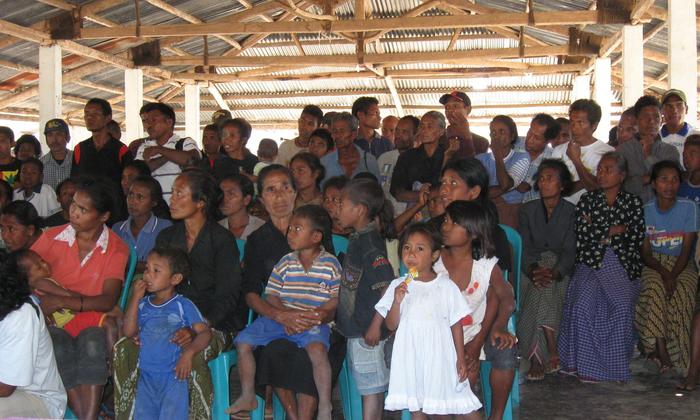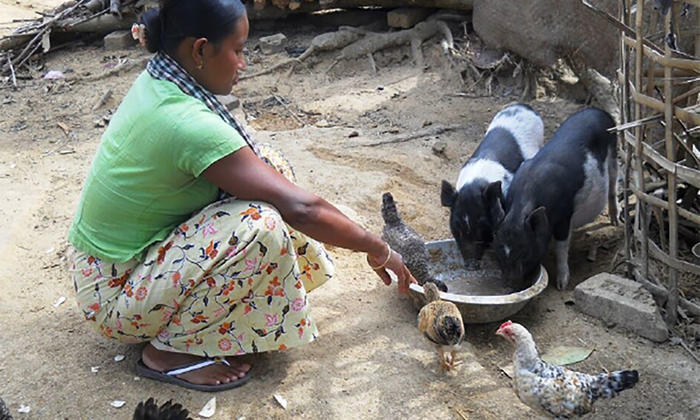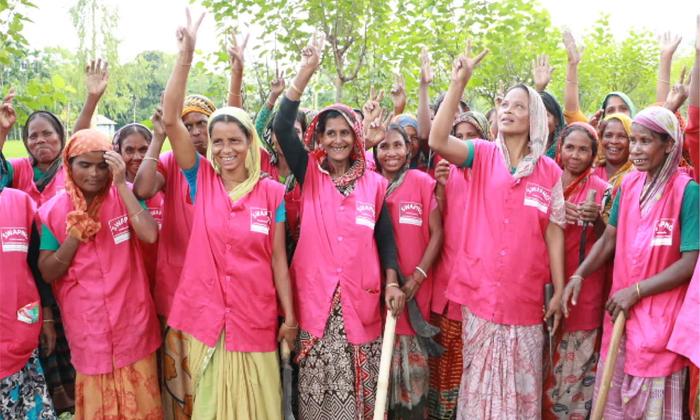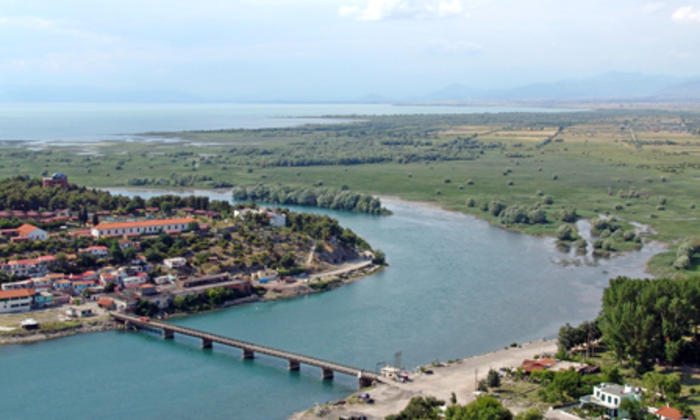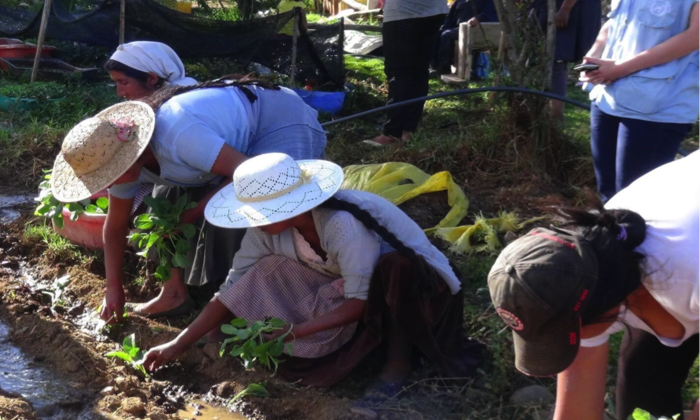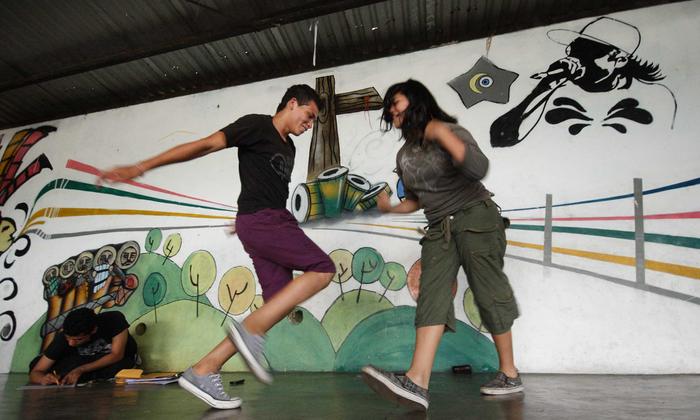The implementation of the programme suffered severed delays caused by the Ebola outbreak, which had a devastating social and economic impact on the country
Case study
Sierra Leone: Enabling Sustainable Livelihoods Through Improved Natural Resource Governance and Economic Diversification in the Kono District
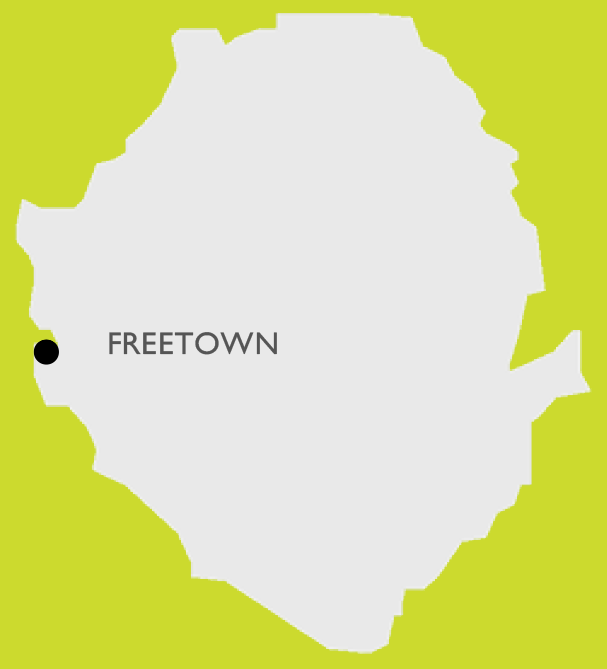
SDGs ADDRESSED
This case study is based on lessons from the joint programme, Enabling sustainable livelihoods through improved natural resource governance and economic diversification in the Kono District
Read more
Chapters
Project Partners
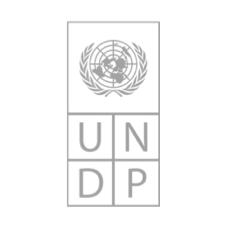
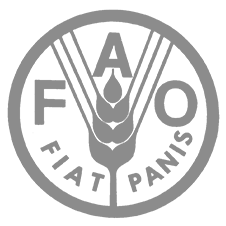
1. SUMMARY
The joint programme was implemented in the Kono district to enhance sustainable and inclusive governance of natural resources as well as diversify sustainable livelihood opportunities for young people and women in agriculture, aquaculture and food processing. The programme promoted public-private partnerships in natural resource governance, and effective dialogue between stakeholders and local development initiatives.
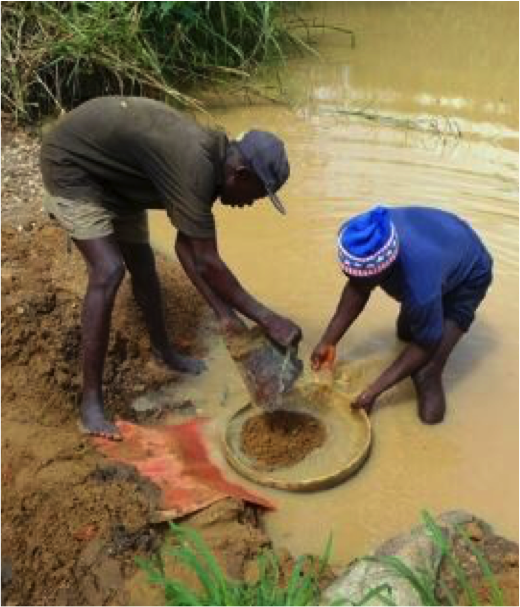
Diamond supplies are reaching their end, so artisanal miners are left with minimal opportunities to secure livelihoods
2. THE SITUATION
Sierra Leone is a country rich in mineral resources, where diamonds are the primary export commodities. But despite vast mineral resources, most people live in poverty (53.8%). The poverty rate is especially high in rural areas (72.2%). Moreover, 10 years of conflict destroyed most of the country’s social, economic, and physical structure. In addition, the 2015 Ebola outbreak exposed the weakness of these systems and specific vulnerabilities such as food security and water and sanitation.
Furthermore, the Ebola outbreak slowed recovery and development. Major challenges include high levels of poverty and unemployment, especially among youth and women. Youth are among the most disadvantaged populations because they lack the skills and resources to be gainfully employed. Approximately 70% of young people are underemployed and live below the national poverty line. Many of the unemployed youth are ex-combatants, who returned to the Kono district seeking quick profits from artisanal mining.
The Kono district was selected as the target region because it has one of the country’s most productive mineral sectors (diamonds and gold), but lacks alternative sources of income and faces environmental degradation. As a result, the Kono district is one of Sierra Leone’s least developed areas, characterized by complex development challenges as well as potential for conflict.
Diamond supplies are reaching their end, so artisanal miners are left with minimal opportunities to secure livelihoods. In addition, the local economy is hampered by low levels of education and skills among young people, limited private sector development, weak local purchasing power, and poor infrastructure. Revenues generated through the extractive sector are not sufficiently invested into local development, where safe drinking water is limited and deep pits dug for diamonds pose serious environmental and health risks. The disconnect between the public’s expectations of returns from mining revenues versus the slow pace of economic and social progress is creating tension and increasing the risk of conflict. In addition, high unemployment rates among youth, limited opportunities for education, health and social services create additional challenges for the Kono district.
3. STRATEGY
The programme strategy promoted an integrated approach through multi-stakeholder collaboration between the UN agencies and key national partners. It focused on governance of natural resources and diversification of livelihoods for young people and women in Kono through job creation and business opportunities. UNDP and FAO’s involvement in their areas of expertise helped provide services, while local organizations facilitated contact with participating communities. The programme’s primary beneficiaries were unemployed young people (15-35 years old) from targeted rural communities, with a particular emphasis on women. The programme focused on targeting beneficiaries living below the national poverty line of $2 per day.
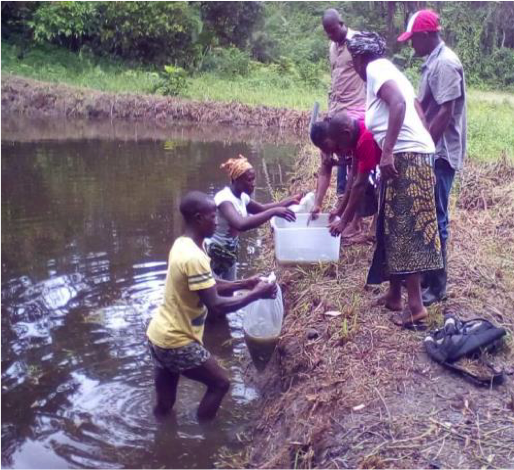
Youth received 800 fingerlings for stocking in pond
The programme’s design considered the fact that Sierra Leone was heavily affected by the Ebola outbreak. While a lot of the emergency funding focused on combating the virus, it was also important to start working on the resilience of individuals and communities post-recovery. The programme invested in sustainable development, employing adaptive methods to reach out to targeted groups as an example of the human-development nexus. The programme’s activities aimed to increase knowledge and inclusive participation in natural resource governance, promote effective dialogue for local development initiatives, and promote alternative livelihood options for poor and disadvantaged young people. The programme had stakeholder engagement, and raised awareness about a land reclamation intervention that involves mining plots of land, including agricultural land.
4. RESULTS AND IMPACT
The programme supported jobs for young people and women, and strengthened local dialogue by taking into account the needs of communities and building capacity locally. Partnerships were formed around agriculture, aquaculture, mini-processing and trade. 650 alternative sustainable livelihoods were created for young people (160 were for women) who started business enterprises or agricultural plots after receiving vocational and entrepreneurship skills.
Young people were trained in 10 vocational skill areas: agriculture, welding, electrification, refrigeration, auto-mechanics, heavy-duty truck driving, heavy-duty machines, operations, block-laying and computer software/hardware. 200 young people, of whom 114 were women, were trained in agribusiness skills and received products to cultivate mined-out reclaimed land (20 acres of land was reclaimed and cultivated for rice, vegetables and economic tree production). Moreover, 150 young people (102 men, 48 women) were trained on natural resource management and got involved in small-scale land reclamation projects. Some artisanal miners expressed a strong desire to start land reclamation when mining operations cease.
To ensure these livelihoods become sustainable, mentorship was provided to all 650 young people so they could understand business startup issues and develop individual or group business plans. In addition, 24 fish ponds and 8 poultry houses were constructed in the Kono district to create alternative sources of income for young people in poultry and fish farming. This increased income for 1,220 young people and helped improve nutrition and food security in the Kono district.
A study was conducted on conflict resolution mechanisms; it identified common issues from mining activities in Koidu and enabled stakeholders to create platforms for open dialogue and dispute resolution without resorting to violence or conflict. More than 450 people (20% women), representing 25 organizations attended sensitisation sessions. An additional 60,000 people were targeted by a mass media outreach campaign on environmental management, mining policies and laws, and advocacy approaches for natural resource management. Training was provided for 60 staff from the Environmental Cadaster Administration System on environmental licensing and monitoring reporting. With support from the Center for International Earth Science Information Network (CIESIN) at Columbia University, the joint programme worked with the Environmental Protection Agency to monitor environmental changes through a centralized GIS database and to train staff to produce, interpret and share information based on satellite images. Open access to GIS databases on natural resource use and environmental changes allowed for an updated cadaster, fostering transparency and accountability.
Support for natural resource governance resulted in the signing with Koidu Holdings of the first community development agreement in the Kono district. A community development agreement is required by law and it allocates revenues from extractive activities to local communities. This type of agreement is usually negotiated between extractive companies and host communities. The community agreement in Kono was the second of its kind signed in the country and followed months of conversations with corporate counterparts. As a result of the agreement, 0.25% of the mining company’s export earnings will be invested in community development. The first payment of US $190,000 was to support community projects that reduce community tensions and poverty.
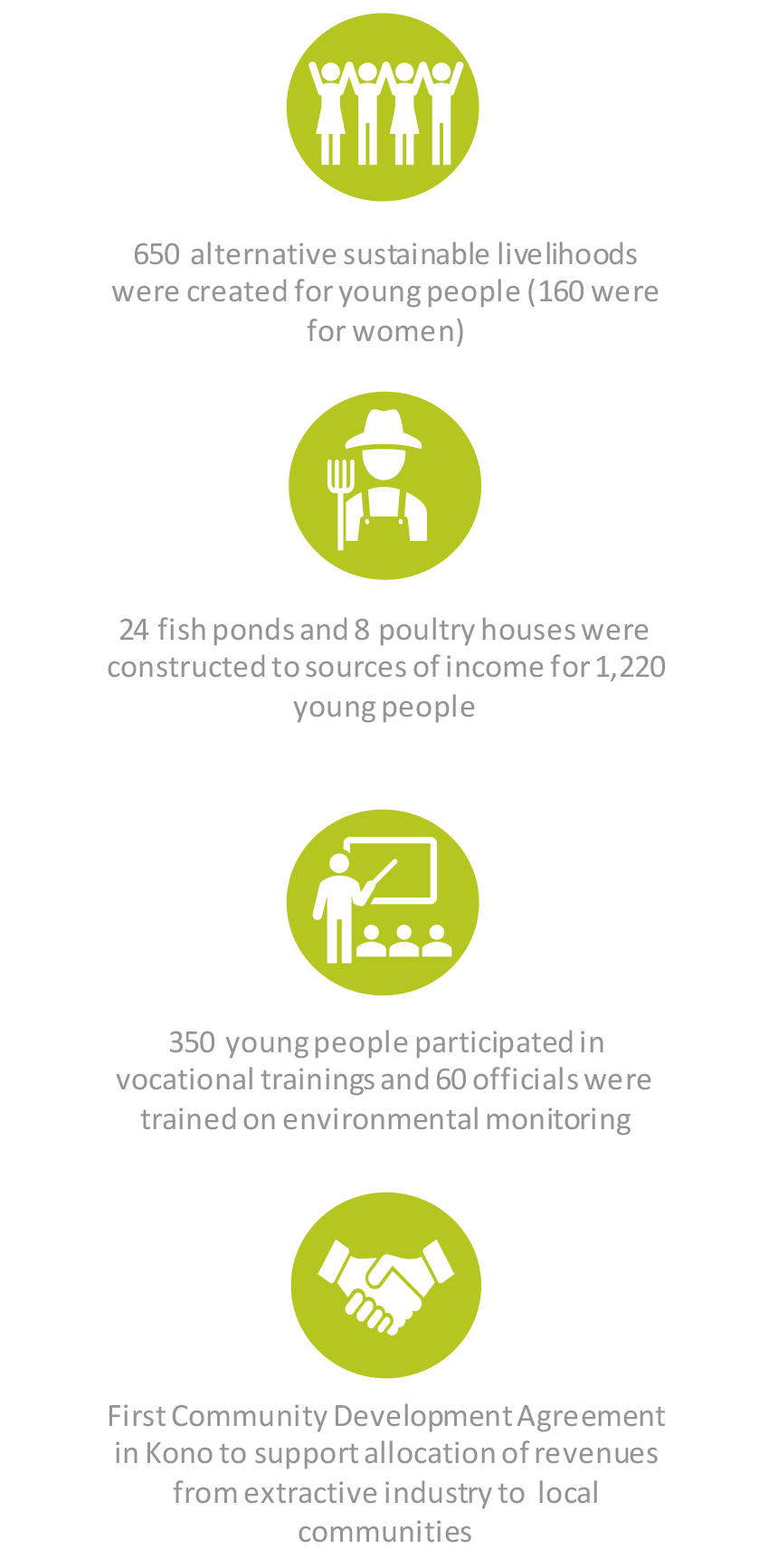
5. CHALLENGES
The joint programme suffered several delays during implementation. Some delays were caused by the Ebola outbreak, which had a devastating social and economic impact on the country. The programme greatly contributed to the response and recovery phases by supporting Kono’s most vulnerable people. In addition, the 2018 national elections had an impact on joint programme implementation as key programme focal points changed.
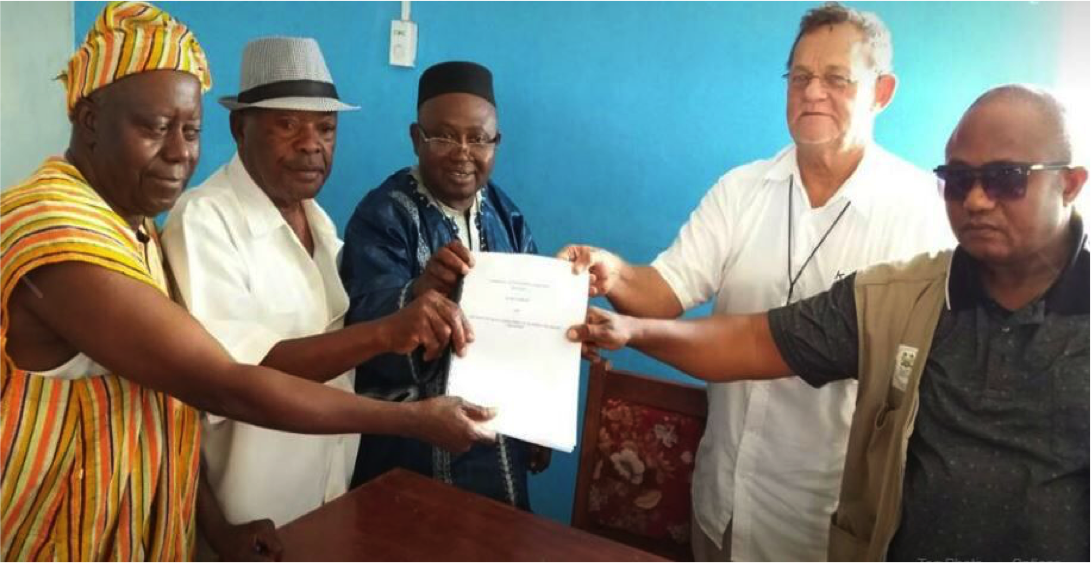
Sogning of Community Development Agreement with extractive industry in Koidu town, committing 0.25% of the mining company’s total export earnings to community development
The programme experienced difficulty with the original budget due to high inflation in the country. There was limited availability of most of the programme’s products, resulting in imports of poultry feed (especially limestone and concentrate). Limited supplies of some equipment also presented a challenge.
Daily allowances for participants’ vocational skills training attracted some youth for the wrong reasons, which demotivated many trainees and affected attendance. Demotivated young people caused some delays in the trainings delivery.
Clarifying the programme’s implementation plans, resources, and enrollment criteria could help manage expectations. The joint programme in Sierra Leone experienced challenges in reaching some distant beneficiary communities as a result of deplorable road conditions and poor communications networks.
6. LESSONS LEARNED
- Aquaculture is a simple, low-cost technology for income generation and food and nutrition security. It supports sustainable livelihood opportunities in remote areas with limited access to agricultural inputs. While formal employment opportunities are scarce in Kono, employment in fishpond production provided sustainable livelihood opportunities for the vulnerable population. With some technical assistance, young farmers were able to take advantage of these opportunities.
- Local stakeholder engagement, sensitization and awareness-raising are crucial for land reclamation activities. With support from the National Mineral Agency and local partners, engagement with key local chiefs and authorities led to prohibition of mining of reclaimed land. This was a significant win for the programme, as noted by the beneficiaries and local partners.
- Gender inclusion had some challenges despite the programme calling for 50% of female youth participants. Only 10% of women (46) participated in vocational skill training. A formal application process may have prevented illiterate young women from applying. Timely involvement of local women’s organizations could attract more young women for similar programmes in the future. A more female-oriented enrollment process should be used to increase the female participants.
- The community development agreement signed in Kono is a wonderful example of how partnerships can contribute to poverty reduction. Months of conversations led to this milestone, despite challenges in conducting dialogue with corporate counterparts. The programme fostered conversation and advocacy plan between civil society organizations, local councils, traditional local authorities, the government, the private sector and local media to create an agreement so that mining could benefit the communities.
- For the first time, it will be possible to reinvest in community development and creation of livelihood sources as a percentage of income (0.25%) of the mining company’s export earnings. The agreement is not only expected to substantially reduce poverty, but also to alleviate tensions between the company and the community.
7. SUSTAINABILITY AND POTENTIAL FOR REPLICATION
The joint programme’s innovative and integrated approach was successful at providing sustainable livelihoods and reversing over-dependence on the extractive industry. The installation of fishponds and henhouses for local development can be replicated in other regions of Sierra Leone to provide sustainable livelihoods and improve food and nutrition security.
A community development agreement, which is an example of an effective public-private partnership, will ensure ownership and sustainability of results. Based on this positive outcome, German Development Agency has funded an additional project in the Kono district focused on strengthening institutional capacity for decision-making, monitoring and evaluation.

